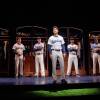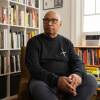To call this a pandemic love story doesn't do it justice.
Kristin Wagner and Toni Guglietti's story may sound familiar. When the pandemic hit, it sped up their plans. They decided to move in together and got engaged, locked inside and overwhelmed with isolation, grief and uncertainty. The couple faced challenges that nearly put an end to their relationship. Now they're sharing the story of how they addressed their issues — spoiler alert, they are now married — and how they did that through the creative outlet of dance.
Their piece, called "cradled in the arms of myself (with you)" reflects on both the strengths and weaknesses of their relationship uncovered while huddled together in a small apartment. It's one of a collection of dance pieces in a larger event called "Refract Reframe Reflections on Loss, Love and Light."
Kristin and Tony joined All Things Considered host Arun Rath to discuss their artistic endeavor. This transcript has been lightly edited for clarity.
Arun Rath: I think a lot of people experienced the kind of pandemic pressure cooker with their relationships. What was it that made you decide to make art out of this experience?
Kristin Wagner: So yeah, that's a good question. What did make us decide that? So I think pretty much the number one thing that you should know about Toni and I is that we had an actual first date, but really our series of really intimate first dates — where we truly got to know each other — were all inside a dance studio. So we met in a dance studio. We got to know each other in a friendly, flirty way in the dance studio. And then I asked him if he wanted to start working on a duet. He said "yes." And then within that timeframe he asked me out, but we were really dating each other while we were making a piece. So it's sort of always been a part of our relationship that we're working out how we get to know each other through movement.
In this case, specifically, he was the only dancer I had access to during the pandemic, and I wanted to keep dancing. So we danced together. And because that was the subject matter of our lives, it kind of just became what the thesis of the piece was.
Tony Guglietti: I remember the week that the pandemic started. I had moved out to her place and we were like, "This will be awesome. We're going to we'll just make up pieces in the kitchen every night and that'll keep us busy," because we thought it would be a couple of weeks. And then of course, probably like a lot of people, we ended up watching movies and hanging out and like the rehearsals in the kitchen kind of dropped off and didn't happen for a while.
But we've always done a show in the summer in Salem, the Salem Arts Festival, where we make a piece for like a 4-by-4-foot little mini stage. As far as I remember, the end of the piece that we're performing now, the original part of it was made for that, and we made it in the kitchen. We taped out the floor and just made a little dance that we could do in place. And as far as I remember, that was the first kind of bit of this whole chunk of this piece.
Rath: I have to confess, I'm not a particularly good dancer. But I like to imagine that great dancers like the two of you when you get together, that you're communicating through dance. Is that the case?
Wagner: Yeah, that's actually how we communicate best. Tony, for a little while, had a policy where we wanted to speak to each other in rehearsal. We would, like, set a timer for like 45 minutes. We would only dance and not speak and make a piece that way so that we would fight less in the studio.
Guglietti: It's hard when you know each other so well. I think, you know, there's no filter or anything. So if you don't like an idea instead of kind of beating around the bush, we're just like, no, I don't want to do that one. So it makes it harder in a way sometimes. So yeah, we tried that as a game one time of rehearsing without talking at all, and it was pretty amazing. We've done it a few times now in shows where we make up a piece on the spot in front of the audience without talking. So yeah, it's definitely a language that we speak best.
Rath: When was the time when you sort of turned the corner when when you realized that actually this is not going to rip us apart, this is going to make us stronger as a couple? When was that in the pandemic?
Wagner: I think when we were when we really when the when the weather was getting nicer. The house that Tony had bought right at the start of 2020 that we ended up rehabbing, it's on a lake. So when we were spending pretty much every weekend of May and June and July, people were starting to emerge, but still not the same as like what we're experiencing now. That was really our our getaway. We would go to the house, we would get some work done, and then we would go out on the lake. And I think it was in those moments of quiet and just like seeing this kind of this home that he was offering to me. That's definitely when I came around and was like, "This is hard, but it's worth it." And yeah, we're going to have something beautiful. It's just going to take a little while to get through this sticky moment.
Rath: I'm super curious about the creative process with dance like this. I mean, being literal minded, I can understand dance if it's, you know, swans or animated toys. But when you're reflecting deep, interior, sometimes abstract emotions, how do you do that?
Guglietti: I'm usually kind of better with either visual things or like really concrete ideas. Instead of saying, "Make up some movement about love or how it feels to lose someone," if I have lyrics in front of me or a picture in front of me, that'll help me. Just kind of start with a phrase and just make up 30 seconds worth of movement based on that. So I remember Kristin coming in to rehearsal with a poem that had just a lot of great imagery, and that's where I started with it, because I get intimidated making up movement just from out of nowhere. I need a game, something to spark, and then I can go. But yeah, I remember a couple of poems that she had that really helped.
Wagner: Yeah, specifically, we used a lot of Pablo Neruda's work. I just find his love poetry is like some of the best love poetry that's ever been created, in my opinion. And like Tony said, he doesn't just write from that emotional standpoint. He uses so much visual and like, just so much visual input that it kind of gave something for everyone to hang on to because I live more in the emotional and the abstract, but Tony lives more in the concrete and the visual. So it was a nice blending, using his work as a catalyst.
Rath: Before we go, tell us a little bit about the other feature, other pieces that are going to be featured in this performance and what stories they tell.
Wagner: So each evening has a different guest soloist. Each of their works deals with some element of loss and/or resilience. There is a group piece that was created by me in each evening as well, so we always have one solo and then our duet and then an ensemble work. And that ensemble work is also sort of an accidental pandemic piece in that it's it started as me just wanting to do something beautiful. And then I really dove into how beauty and joy and simplicity helps us survive, especially through challenging times.
Arun: Brilliant. Kristin and Tony, it has been a pleasure speaking with you both. Thank you.
Wagner: Thank you.
Guglietti: Thanks for having us.
Arun: That was Kristin Wagner and Tony Guglietti about their dance, "cradled in the arms of myself (with you)," which you can see this weekend at the Foundry in Cambridge.







